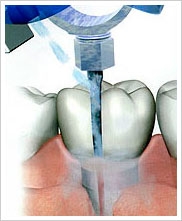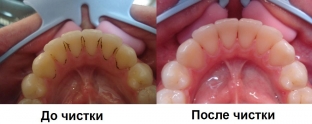During the processing of food in the oral cavity, food debris can collect in the form of plaque and calculus on the teeth, as well as in the periodontal pocket. When brushing your teeth, plaque can be removed, but the brush will not be able to get into the pocket of the gums.
As a result, a bacterial infection joins and periodontitis develops, which is accompanied by bleeding gums, loose teeth, which leads to tooth loss.
Deposits in periodontal pockets are removed mechanically with a curette or surgically. Recently, ultrasonic cleaning of teeth has been practiced. However, these methods have some drawbacks.
Disadvantages of mechanical and ultrasonic cleaning
Mechanical methods of toothbrushing, as well as ultrasonic toothbrushing, have a number of disadvantages, which in some cases lead to the need for surgical removal of the contents of the dentogingival pocket.
Disadvantages of mechanical and ultrasonic cleaning
- These methods can only eliminate contents from a periodontal pocket up to a depth of 5mm.
- These procedures cannot be performed without damage to the deep tissues of the gums and the surface of the tooth near the roots.
- During ultrasonic cleaning of teeth, removal in hard-to-reach places for the curette is possible, but the ultrasound has chaotic vibrations, and the device is very hot, which leads to painful sensations for the patient.
- The tooth surface is not always polished with high quality, plaque and deposits remain on the tooth surface.
In view of these shortcomings, the new Vector dentifrice was created. This is a German ultrasonic dental cleaning unit, in which all the shortcomings of the previous methods are eliminated.
Professional teeth cleaning with Vector. Benefits of the new machine
The Vector is designed for professional teeth cleaning and is capable of destroying deposits in a non-contact way. The use of the new apparatus has gained popularity due to its efficiency and comparative speed of the process.
There are no shortcomings in the operation of this installation, which are present in other ultrasonic devices. This is because the ultrasonic waves in the device are directed longitudinally, which allows you to act only on diseased tissues without touching healthy ones. This does not cause pain.
The ultrasonic vibrations are transmitted to the instrument through a resonant circuit, and ordered vibrations are communicated, which clean the teeth along the surface to be cleaned. Due to such ordered oscillations of ultrasound, all conditions are created in the apparatus for deeper penetration of waves and cleansing in hard-to-reach places of the dentogingival pocket. With such a professional cleaning of the teeth, dentin and tooth enamel do not suffer. So, ultrasonic cleaning of teeth with the device allows you to penetrate to a depth of up to 11 mm. This makes it possible to treat periodontitis without surgical methods.
Vector ultrasonic cleaning procedure
 New dentifrices, including the Vector ultrasonicator, effectively remove plaque, biofilm, tartar and toxins from the pocket. Also, with ultrasonic cleaning of the teeth, the bacteria that caused the disease die. In this case, the instrument does not come into contact with the tooth surface, ultrasound is transmitted through a liquid medium.
New dentifrices, including the Vector ultrasonicator, effectively remove plaque, biofilm, tartar and toxins from the pocket. Also, with ultrasonic cleaning of the teeth, the bacteria that caused the disease die. In this case, the instrument does not come into contact with the tooth surface, ultrasound is transmitted through a liquid medium.
Before the procedure, the patient undergoes appropriate tests. The ultrasonic cleaning procedure is performed without anesthesia.
The whole ultrasonic cleaning procedure lasts from 45 minutes to 2 hours, depending on the specific situation.
For ultrasonic cleaning of teeth, the device uses flexible instruments that consist of composite materials. This design makes it possible to clean surfaces that have a complex shape - deep-seated implants and tooth roots.
When treating a dental pocket, a mixture is filled into the apparatus, which contains particles of hydroxyapatite up to 10 nm in size. These particles vibrate in an orderly manner in the zone of action of ultrasound and remove subgingival deposits from the periodontal pocket, as well as effectively polish the tooth surface. Hydroxyapatite contributes to the rapid restoration of the gums after ultrasonic cleaning of the teeth. Affected areas of the gums are destroyed at a microscopic level, which is impossible with other methods of brushing your teeth
Results of ultrasonic cleaning of teeth and the possibilities of the device
After 2 weeks after ultrasonic cleaning, the patient should visit the dentist again to monitor the effectiveness of the process and determine the need for a second procedure. Subsequent several visits should be made every one and a half months, when the specialist observes the presence of recurrence of plaque.

The use of an ultrasonic toothbrush can reduce tooth mobility, strengthen the soft tissues of the gums and stop the formation of plaque.
Undoubtedly, new methods of brushing teeth are effective, reliable and less painful. Prophylactic ultrasonic cleaning can help prevent periodontal disease, as well as unpleasant symptoms such as bleeding gums, loose teeth, and bad breath.







Add a comment